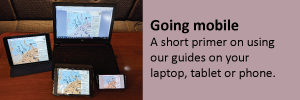Getting high on Hornby

Many baby boomers, for example, think of the island as a hangout for aging hippies. GenX’ers, meanwhile, might see the residents as squatters who were magically transformed into affluent speculators as their communes gentrified.

And leave it to millennials to see the island as an outdoor playground. They know Hornby for its vast network of hiking and biking trails that lead high into the unspoiled parkland that dominates the island’s hilly interior. And they tend to see the wilting flower-power proclivities of island residents as quaint but irrelevant.
Boaters who return year after year to their favourite anchorages on Hornby Island, fall in either camp or somewhere in between. Though it’s surprising how many cruisers we meet who have never gone trekking here. They enjoy the beach, maybe walk to the co-op for a bottle of wine, but don’t go much farther afield.
Of course, if they all hit the trails, there might be no getting rid of them. So perhaps that’s why residents don’t make a big deal about hiking their island.
The network of trails in the highlands is complicated and without a map it would be easy to get lost. Luckily, anyone with a smartphone or tablet with GPS will find that the trails are quite well marked and easily followed on Google Maps.
Where you choose to anchor — in Tribune Bay or around the corner near Ford Cove and Shingle Spit — will determine which trails are most easily accessed, but walkers can reach most any trail from any anchorage if they have an early start.
From Shingle Spit, walkers really have two options. They can hike the aptly named Shingle Spit to Ford Cove Trail which follows the waterfront southeast to Ford Cove. Or, if they want a quicker ascent to high ground, they can walk north on Shingle Spit Road for about 250 metres, turning right on Mount Road. About 1km along, hikers will come to a parking lot and trailhead for Middle Bench Trail which follows the Mt Geoffrey Escarpment southeast, eventually merging with other trails which lead to Mt Geoffrey’s summit.

From Ford Cove, hikers will most easily reach the high trails by walking east along Central Road for about 2km, then turning left on Euston Trail. Again, the turn off is much easier to find with Google Maps.
About 400 metres along, Euston Trail meets Euston Road. Continue west for 1km to the trailhead for Parson’s Link Trail and Middle Bench Trail. From here, the world is your oyster.
From Tribune Bay Beach, there are a variety of routes walkers can take to get to the high country. Perhaps easiest is to locate the Co-op shopping centre west of the beach. Walk south 500 metres to Slade Road. Turn right. After 1.2km you’ll find a trailhead that leads into the Norm Walton Forest and Watershed. Again, the options from here are endless.
A convenient and easy walk from Tribune Bay is to Helliwell Provincial Park. Walk northeast along the Tribune Bay Trail to St. John’s Point Road, then southeast for about 2km to the park entrance.

The walks through Helliwell provide stunning views. Hike along the shore from St. John Point to Mushroom Beach. It’s possible to return to Tribune Bay via the High Salal Public Trail which follows the shoreline, meeting up with High Salal Drive outside the park.
No matter which reputation springs to mind when you think of Hornby Island, if you take to the high ground, that’s an image that will stay with you for a long time.
Hornby Island is covered in Salish Sea Pilot’s guide to the Sunshine Coast.


















